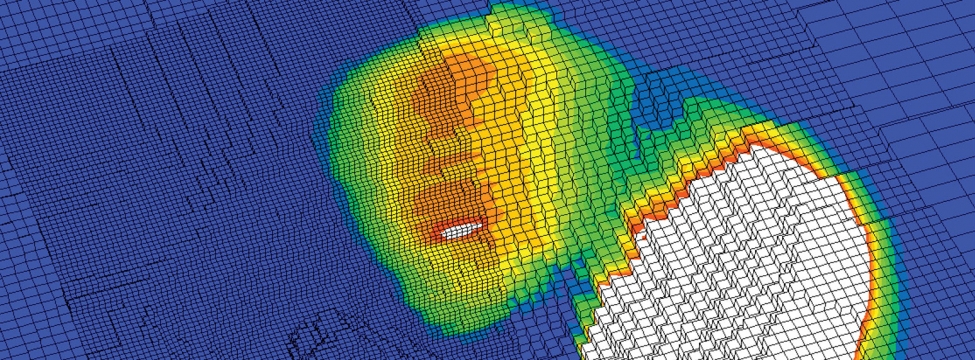To serve you better, our new website displays information specific to your location.
Please visit the site and bookmark it for future use.
3D modelling structurally controlled weak rock masses using blockiness
Design of deep open pits in structurally complex, weak deformable rock masses is a challenge. Recently, SRK in conjunction with HTA Consulting, engaged in assessing the slope stability for such a proposed pit. Experience has shown that incorporation of the Geotechnical Blockiness Index (GBI) within the 3D geotechnical domain model improves our ability to simulate pit design performance.
The digital geotechnical domain model, developed by project staff and HTA, consisted of four classifications: lithology, oxidation state, alteration and GBI. The rock mass was pided into design sectors based on Mohr-Coulomb properties and ubquitous jointing, extensive laboratory testing and field investigation. The figure at right shows variability in the distribution of different material types.
The numerical codes Slide, Phase2 and FLAC3D were used to assess potential instability. This staged approach raised confidence in the controlling instability mechanisms and the interaction of 3D confinement on slope performance. Applying strength reduction factors (SRF) to the FLAC3D solution also demonstrated the potential development and extent of open pit instability. The figure above indicates zones of velocities with cool colors referring to low, warm colors to moderate, and white color, high velocities.
The FLAC3D runs incorporated rock mass and fabric variability to assess the sensitivity of the slope response. Comparison of the 2D and 3D models allowed a re-evaluation of the expected rock mass performance so that the model results could be applied realistically to the slope design accounting for pit concavity.
Conclusions from the study indicated:
• The application of the GBI improved the quality of the geotechnical data set and enabled better definition of areas of poor rock mass quality
• The use of 3D modelling to assess the critical design criteria, using detailed geotechnical and structural domain model, provided a sound basis for a reassessment of the slope design
• 3D and 2D analyses were used to simulate slope performance and provide guidance on pit slope design. 3D analysis show an increase in SRF, compared to the 2D analyses (typically 20 to 30% higher)
• FLAC3D results were used to review the existing 2D slope design parameters resulting in steeper than recommended slope geometry
Jeff Price: jprice@srk.com.au
|
You can download a PDF of the entire |
PDF
A4 |
PDF
Letter |
|
|
|
Our newsletters focus on specific areas of interest to earth resource professionals and clients. Each is available as an Adobe Acrobat PDF file. If you don't already have Adobe's PDF reader, you can download it free.
![]()


